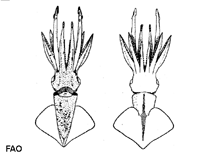Abraliopsis pfefferi Joubin, 1896
Pfeffer's enope squidWarning: DOMDocument::load(): SSL operation failed with code 1. OpenSSL Error messages: error:140770FC:SSL routines:SSL23_GET_SERVER_HELLO:unknown protocol in C:\Apache24\htdocs\includes\SpeciesSummary.lib.php on line 1236
Warning: DOMDocument::load(): Failed to enable crypto in C:\Apache24\htdocs\includes\SpeciesSummary.lib.php on line 1236
Warning: DOMDocument::load(https://sealifebase.nrm.se/webservice/AquaMaps/getAMap.php?genus=Abraliopsis&species=pfefferi): failed to open stream: operation failed in C:\Apache24\htdocs\includes\SpeciesSummary.lib.php on line 1236
Warning: DOMDocument::load(): I/O warning : failed to load external entity "https://sealifebase.nrm.se/webservice/AquaMaps/getAMap.php?genus=Abraliopsis&species=pfefferi" in C:\Apache24\htdocs\includes\SpeciesSummary.lib.php on line 1236
Classification / Names Common names | Synonyms | CoL | ITIS | WoRMS
| Oegopsida | Enoploteuthidae
Environment: milieu / climate zone / depth range / distribution range Ecologia
Pelagico; distribuzione batimetrica 1 - 750 m (Ref. 804). Tropical
Distribuzione Stati | Aree FAO | Ecosystems | Presenze | Introduzioni
Atlantic Ocean: Madeira, Namibia and the High Seas.
Length at first maturity / Size / Peso / Age
Maturity: Lm ? range ? - ? cm Max length : 7.0 cm ML maschio/sesso non determinato; (Ref. 2399)
Minimum depth from Ref. 110525. Mesopelagic (Ref. 804).
Life cycle and mating behavior Maturità | Riproduzione | Deposizione | Uova | Fecundity | Larve
Members of the class Cephalopoda are gonochoric. Male and female adults usually die shortly after spawning and brooding, respectively. Mating behavior: Males perform various displays to attract potential females for copulation. During copulation, male grasp the female and inserts the hectocotylus into the female's mantle cavity where fertilization usually occurs. Life cycle: Embryos hatch into planktonic stage and live for some time before they grow larger and take up a benthic existence as adults.
Main reference
Bibliografia | Coordinatore | Collaboratori
Nesis, K.N. 1987. (Ref. 2399)
IUCN Red List Status (Ref. 130435)
CITES status (Ref. 108899)
Not Evaluated
CMS (Ref. 116361)
Not Evaluated
Threat to humans
Human uses
| FishSource |
Strumenti
Informazioni ulteriori
Age/Size
Accrescimento
Length-weight
Length-length
Morfologia
Larve
Abbondanza
Accrescimento
Length-weight
Length-length
Morfologia
Larve
Abbondanza
Fonti Internet
BHL | BOLD Systems | CISTI | DiscoverLife | FAO(Publication : search) | Fishipedia | GenBank (genome, nucleotide) | GloBI | Gomexsi | Google Books | Google Scholar | Google | PubMed | Tree of Life | Wikipedia (Go, ricerca) | Zoological Record
Estimates based on models
Preferred temperature
(Ref. 115969): 10.5 - 16, mean 14.1 (based on 269 cells).



